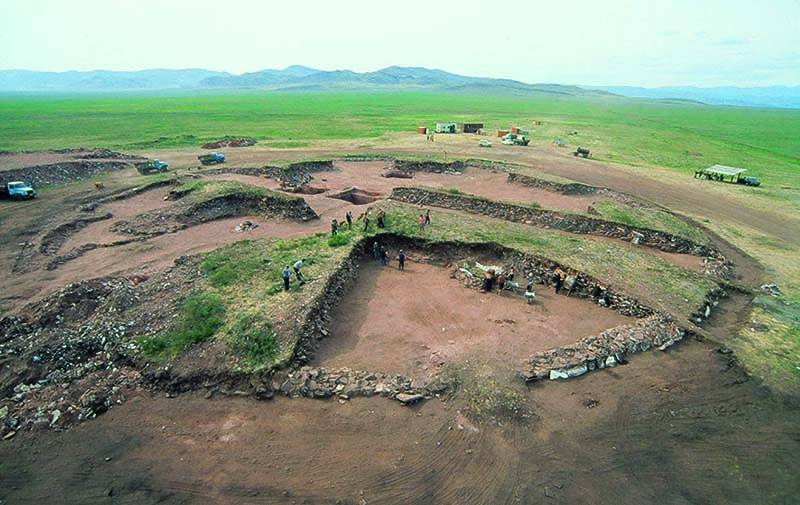

The most obvious archeological remains associated with the Scythians are the great burial mounds called Kurgans some over 20 metres high, which dot the Ukrainian and Russian steppe belts and extend in great chains for many kilometers along ridges and watersheds. From them much has been learnt about Scythian life and art. Burial mounds are complex structures with internal chambers.
A kurgan is a type of tumulus constructed over a grave, often characterized by containing a single human body along with grave vessels, weapons and horses. Originally in use on the Pontic–Caspian steppe, kurgans spread into much of Central Asia and Eastern, Southeast, Western and Northern Europe during the 3rd millennium BC. The earliest kurgans date to the 4th millennium BC in the Caucasus, and researchers associate these with the Indo-Europeans. Kurgans were built in the Eneolithic, Bronze, Iron, Antiquity and Middle Ages, with ancient traditions still active in Southern Siberia and Central Asia.
Within the burial chamber at the heart of the kurgan, elite individuals were buried with grave goods and sacrificial offerings, sometimes including horses and chariots. The structures of the earlier Neolithic period from the 4th to the 3rd millenniums BC, and Bronze Age until the 1st millennium BC, display continuity of the archaic forming methods. They were inspired by common ritual-mythological ideas. Read more
2,500-year-old burial mound found in Siberia's 'Valley of the Kings' dating to more than 2,500 years ago Live Science - March 29, 2022
The ancient tomb holds the remains of five people, including those of a woman and toddler who were buried with an array of grave goods, such as a crescent moon-shaped pendant, bronze mirror and gold earrings. The mounds were made by the Scythians - a term used to describe culturally-related nomadic groups that lived on the steppes between the Black Sea and China from about 800 B.C. to about A.D. 300.
The burial mound, known as a kurgan, is located near a previously excavated kurgan belonging to a Scythian chief. Given the proximity of the woman's burial mound to the chief's - only 656 feet (200 meters) away - and the valuable artifacts buried with her.
Archaeologists have known about the "Valley of the Kings" (a phrase coined by a journalist years ago, harkening Ancient Egypt's Valley of the Kings) for more than a century. This vast valley, known as Touran-Uyuk in Tuva, a Russian republic, is replete with numerous Scythian royal burials.
One of the previously excavated kurgans, dating to the eighth or ninth century B.C., holds the earliest known elite Sythian burial ever found. Most of these kurgans, however, have yet to be formally excavated.
At the invitation of Russian archaeologists, Oleszczak and his team conducted excavations in the valley during the 2019 and 2021 field seasons. The kurgan, detected by aerial laser scanning, is about 82 feet (25 m) in diameter and has a destroyed, flattened center, according to Science in Poland, a news site coordinated by the Polish government and independent journalists. The kurgan is relatively short today - just 12 inches (30 centimeters) high. During excavations, the archaeologists found the burials of five people. In one chamber, at the center of the kurgan, the researchers found a looted burial chamber with weapons, including arrows, suggesting that a warrior had been buried there.
Scythians, ice mummies and burial mounds British Museum - August 23, 2017

The Scythians buried their dead and marked their tombs with burial mounds. There are tens of thousands of these mounds scattered across the vast steppe region which stretches from northern China through southern Siberia to the northern Black Sea.
7,000 year old Siberian warrior: more advanced than we supposed? Siberian Times - October 14, 2015
In a first for Siberia, a burial mound dating to the 'New Stone Age' has been unearthed in Novosibirsk region. In the mound were nine people, including women and children, discovered by archeologists and students from Kemerovo State University. In the lower layer, they discovered a man with a stone axe and a horn tipped arrow,' said the university's press service. It is a fair assumption to say, as this fact proves, that the burial mounds emerged much earlier than the Bronze Age, in Neolithic times.